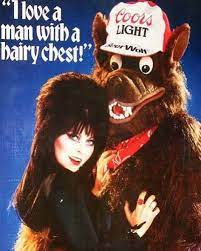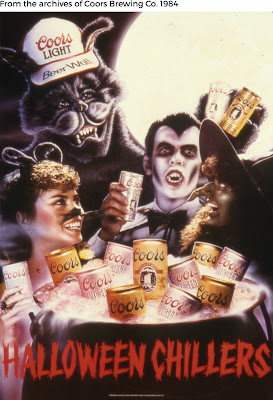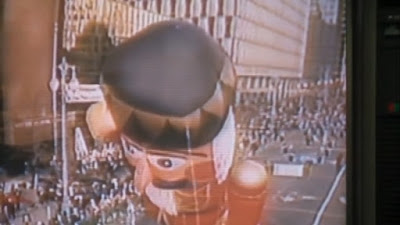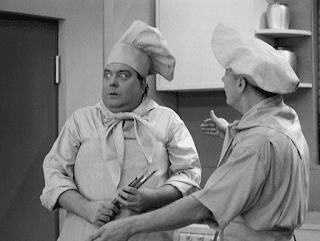The Wall Street Journal proclaimed in 1986, "Halloween, once a romp for kids clad as pirates and princesses, now rivals Saint Patrick's Day and New Year's Eve as party time for adults. Blame it on Elvira!"
I've never been much of a beer drinker, but in college, my friends all enjoyed "The Silver Bullet." I'm sure during our poor college student days, it had a lot more to do with price point than any ad campaign, but they sure did like their Coors Light!
Growing up in a teetotaler family as a child, my view of alcohol and beer was that it was "bad stuff for bad people." Mainly because the Church we went to, my Grandparents, and Parents would often remind me it was the cause of a lot of problems in the world (arguably true) and the first step down a road to a life of evil and wrong-doing. Think Edie McClurg's character Chastity Pariah in "Mistress of the Dark."
That said, I can clearly remember times at the grocery store (Grand Union) with Grandma or Mom, or at Lane's Deli with Gramps, or at the gas station with Dad, and seeing one advertisement that piqued my interest in the seemingly "naughty" adult world of mass-market beers. It was Elvira, the Queen of Halloween, promoting Coors Light.
In 1983 a battle amongst the major beer companies was brewing (very punny). Big competitors were spending large amounts of money on advertising for beer-buying summer holidays like Memorial Day, Fourth of July, or Labor Day. The winter holidays, Thanksgiving and Christmas, were big beer holidays as well as folks often let their hair down at the end of the year during parties with friends, family, and coworkers.
Coors Light wanted to "own" a holiday, and Halloween was available, but Coors Light was a small brand back then. While it may be the number 2 beer brand by sales today, it wasn't available nationwide until 1991.
By 1985, the Beer Wolf campaign was beginning to stall out, so Coors Light turned to someone synonymous with Halloween. Known at the time only on the Pacific Coast for her late-night horror movie show, Elvira joined the 1986 Halloween ad campaign as the first female celebrity ever to endorse beer. The "Queen of Halloween" was an immediate success with the beer buying public as the campaign hit television airwaves nationwide. Coors placed life-size cardboard standups of Elvira next to their products in grocery stores, liquor stores, and gas stations everywhere, along with the television ads. Whose attention wouldn't be captured with something like that? Those life-size cutouts were so popular they began disappearing faster than the beer makers could make them.
Phil Senes, the Manager of Promotions for Coors, at the time said, "We couldn't keep the displays up at retail. The consumers, competitors, and store personnel were taking the Elvira standups out of the stores as fast as we could stock them!"
As 1986 came to a close, the Elvira partnership was arguably the most successful beer campaign ever. It certainly was for Coors Light, and she was quickly asked to return in 1987.
In 1987, the very conservative, very religious Coors family decided to tone down Elvira's trademark sexiness. They insisted she cover her cleavage with hair or different cuts to her clothing. The trademark hip-high slit in her dress was removed, and she was often seen standing behind stacks of Coors products or other props. The promotion was still successful, but the red-blooded American males purchasing beer certainly took notice.
Then in 1988, urban legends about satanic cults swept the nation. While that's a long story for another day, suburban housewives everywhere began thinking that cults were abducting children in the woods behind their homes at alarming rates. Mega-conglomerate Proctor and Gamble was swept up in the media frenzy, and rumors soon began swirling that the CEO had made personal donations to the Church of satan. P&G spent large sums of money fighting these rumors in the court of public opinion, and for quite some time, their reputation was tarnished.
Over a decade later, when I was a high school junior in 2001, my economics teacher still believed 100% the Proctor and Gamble logo was a secret satanic symbol.
The Coors family worried their company was the next target for this early form of cancel culture, especially when their spokeswoman called herself "The Mistress of the Dark." Company President Jeffrey Coors decided to kill the Elvira ad campaign at the height of its overwhelming success. In internal documents and occasionally even publicly, he claimed a deep sense of fear and revulsion when looking at Elvira's photos. I'd wager it wasn't fear and revulsion that he was feeling, but what do I know? He called her demonic and cut off the ad campaign before the start of the 1988 Halloween season.
The ad campaign was dead, and Elvira was no longer the spokeswoman for the "Official Beer of Halloween." Not long after, Elvira was hired by Pepsi to promote Mug Root Beer. That sounds like a good article for next year's Halloween, but this was during the time Pepsi was using the "Universal Monsters" in one of the most iconic Halloween ad campaigns of our time. The new connection with Pepsi, Universal, and Hollywood kept Elvira in the public eye and tied to Halloween.
When Pepsi moved on to other promotions, Coors returned to Elvira with their hat in hand after several failed promotions. You may remember the somewhat infamous "Roctoberfest," where several young women dressed in tight silver dresses danced and sang around attractive young men. When sex didn't sell, the company turned to actor Leslie Neilsen to play a bumbling detective. For two years, Neilsen appeared in ads like "Phantoms in the Fridge" and "The Search for Halloween's Headquarters." Those commercials brought in lackluster sales, proving that comedy wasn't quite the answer either.
If sex didn't sell, and neither did comedy, then perhaps sex AND comedy would! Who better to do both than Elvira!
Elvira returned for several successful Halloween seasons that once again led to a rapid increase in sales for Coors. During this time, Elvira appeared in the "Mali-boo" ad campaign that my generation likely remembers most. This campaign features Elvira and several monsters and zombies on "Mali-Boo" Beach as she hawks Coors Light. A funny little commercial that was cute but led to an even bigger promotion featuring a surfer-dude Frankenstein.
The above commercial is cute enough and one I certainly remember seeing on television frequently back then. I think the Mali-Boo campaign reached the peak of its success, though, when they adapted the Frankenstein character into a neon color-wearing surfer-dude getting up-close-and-personal with Elvira. Those cardboard standees are some of the most popular ones today for collectors and Elvira fans.
At the end of 1995, Elvira and Coors announced an amicable split between the two parties. Elvira's run as "The Queen of Halloween" came to an end.
However, Cassandra Peterson says in Elvira's recent memoir "Yours Cruelly, Elvira," it wasn't exactly a peaceful departure. She claims that the Coors executives admitted that the Mali-Boo campaign in 1995 was their most successful yet but had decided to scale back her presence in 1996.
During their negotiations for 1996, they informed Elvira that the life-size cutouts would be replaced with countertop-sized minis to reduce cost. Then, they told her that she wouldn't appear in any television or radio ads. Not appearing in the TV ads would cut Elvira's compensation in half, and so she decided to part ways with the beer makers.
As it turned out, Joseph Coors Sr had told his staff to end the partnership regardless of the loss in sales. The near 80-year-old somewhat retired executive claimed to see demons surrounding Elvira when he looked at her. Bringing up the same satanic rumors from years past, the Coors family once again got cold feet when it came to partnering with The Mistress of the Dark. In her memoir, Elvira mentions she often wonders if these moves made by Coors were a way to lay the blame of failure at her feet following what would surely be a disappointing sales year given the new stipulations from Joseph Coors Sr.
Also happening simultaneously, Mothers Against Drunk Driving (MADD) had set their sights on Halloween, drunk driving, and children's safety. Coors feared negative repercussions and a destructive news cycle and decided to back away from advertising as much for Halloween as they had in the past.
In one final dash of salt in her wounds, Coors went and copyrighted Elvira's moniker "The Queen of Halloween." Having used the term since 1981 during her Movie Macabre show, the beer makers used the title long after ending their connection to Elvira. The following year, Coors gave the title to Pamela Anderson. Over the years, other stars like Heidi Klum, Jenny McCarthy, Daisy Fuentes, and Salma Hayek have all been featured by Coors with the moniker. Eventually, the company stopped using celebrities and began to use anonymous attractive young women in skimpy outfits.
 |
| Daisy Fuentes as "The Queen of Halloween" |
Elvira's ties to beer didn't end in 1995, however. Early in 1996, a pair of executives from Coors, Bob Fox and Mike Wiley, quit the company. In part, because of the silly decisions being made by the executive team being forced upon the marketing department, the pair were looking to start their own brand. The two found a group of investors to rehabilitate a failing craft brewery in Minnesota, and Elvira's Brewhouse, Inc was born. The Brewhouse quickly launched "Elvira's Night Brew" and advertised it as a "dark, full-bodied, and ro-bust lager." Get it?
Elvira's Night Brew made Elvira the first celebrity to market their own beer, a trendy activity today nearly 30 years later. Unfortunately, the Night Brew didn't last long. The venture capitalists keeping the brewery afloat financially backed out, and the company's Initial Public Offering (IPO) of stock never materialized.
In just over a year, despite being available in 40 states nationwide, Elvira's Night Brew came to an end... and so did Elvira's run as a beer saleswoman.











.png)




Comments